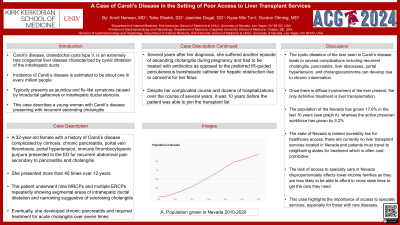Tuesday Poster Session
Category: Liver
P4730 - A Case of Caroli’s Disease in the Setting of Poor Access to Liver Transplant Services
Tuesday, October 29, 2024
10:30 AM - 4:00 PM ET
Location: Exhibit Hall E

Has Audio

Amrit Narwan, MD
Kirk Kerkorian School of Medicine at the University of Nevada
Las Vegas, NV
Presenting Author(s)
Amrit Narwan, MD1, Taha Shaikh, DO1, Jasmine Dugal, DO1, Kyaw Min Tun, DO2, Gordon Ohning, MD, PhD1
1Kirk Kerkorian School of Medicine at the University of Nevada, Las Vegas, NV; 2Creighton University School of Medicine, Las Vegas, NV
Introduction: Caroli’s disease, choledochal cysts type V, is an extremely rare congenital liver disease characterized by cystic dilatation of the intrahepatic ducts. It occurs in only one out of every one million people. It typically presents as jaundice and flu-like symptoms caused by intraductal gallstones or intrahepatic ductal stenosis. This case describes a young woman with Caroli’s disease presenting with recurrent ascending cholangitis.
Case Description/Methods: A 32-year-old female with a history of Caroli’s disease complicated by cirrhosis, chronic pancreatitis, portal vein thrombosis, portal hypertension, immune thrombocytopenic purpura presented to the ED more than 40 times over 12 years with recurrent abdominal pain related to pancreatitis and cholangitis. The patient underwent nine MRCPs and multiple ERCPs repeatedly showing segmental areas of intrahepatic ductal dilatation and narrowing suggestive of sclerosing cholangitis. Eventually, she developed chronic pancreatitis and required treatment for acute cholangitis over seven times. Several years after her diagnosis, she suffered another episode of ascending cholangitis during pregnancy, and had to be treated with antibiotics as opposed to the preferred IR guided percutaneous transhepatic catheter for hepatic obstruction due to concerns for her fetus. Despite her complicated course, she was unable to enlist for transplant due to lack of transplant hepatology in Nevada. Ultimately, the patient was placed on a transplant list in California more than 10 years after her diagnosis with Caroli’s disease.
Discussion: The manifestations of Caroli’s disease, such as recurrent ascending cholangitis or biliary obstruction are typically managed medically with antibiotics and IR procedures until a majority of the liver is affected. Once there is diffuse involvement of the liver present, the only definitive treatment is liver transplantation. Unfortunately, the lack of access to liver transplantation services in Nevada meant our patient was not enlisted for transplant until several years after her diagnosis. This case highlights the importance of access to specialty services, especially for those with rare diseases. Unfortunately, the state of Nevada is ranked incredibly low for healthcare access. As the population of Nevada continues to grow, the need for access to specialty services becomes critical. The lack of access disproportionately affects lower income families as they are less likely to be able to afford to cross state lines to get the care they need.
Disclosures:
Amrit Narwan, MD1, Taha Shaikh, DO1, Jasmine Dugal, DO1, Kyaw Min Tun, DO2, Gordon Ohning, MD, PhD1. P4730 - A Case of Caroli’s Disease in the Setting of Poor Access to Liver Transplant Services, ACG 2024 Annual Scientific Meeting Abstracts. Philadelphia, PA: American College of Gastroenterology.
1Kirk Kerkorian School of Medicine at the University of Nevada, Las Vegas, NV; 2Creighton University School of Medicine, Las Vegas, NV
Introduction: Caroli’s disease, choledochal cysts type V, is an extremely rare congenital liver disease characterized by cystic dilatation of the intrahepatic ducts. It occurs in only one out of every one million people. It typically presents as jaundice and flu-like symptoms caused by intraductal gallstones or intrahepatic ductal stenosis. This case describes a young woman with Caroli’s disease presenting with recurrent ascending cholangitis.
Case Description/Methods: A 32-year-old female with a history of Caroli’s disease complicated by cirrhosis, chronic pancreatitis, portal vein thrombosis, portal hypertension, immune thrombocytopenic purpura presented to the ED more than 40 times over 12 years with recurrent abdominal pain related to pancreatitis and cholangitis. The patient underwent nine MRCPs and multiple ERCPs repeatedly showing segmental areas of intrahepatic ductal dilatation and narrowing suggestive of sclerosing cholangitis. Eventually, she developed chronic pancreatitis and required treatment for acute cholangitis over seven times. Several years after her diagnosis, she suffered another episode of ascending cholangitis during pregnancy, and had to be treated with antibiotics as opposed to the preferred IR guided percutaneous transhepatic catheter for hepatic obstruction due to concerns for her fetus. Despite her complicated course, she was unable to enlist for transplant due to lack of transplant hepatology in Nevada. Ultimately, the patient was placed on a transplant list in California more than 10 years after her diagnosis with Caroli’s disease.
Discussion: The manifestations of Caroli’s disease, such as recurrent ascending cholangitis or biliary obstruction are typically managed medically with antibiotics and IR procedures until a majority of the liver is affected. Once there is diffuse involvement of the liver present, the only definitive treatment is liver transplantation. Unfortunately, the lack of access to liver transplantation services in Nevada meant our patient was not enlisted for transplant until several years after her diagnosis. This case highlights the importance of access to specialty services, especially for those with rare diseases. Unfortunately, the state of Nevada is ranked incredibly low for healthcare access. As the population of Nevada continues to grow, the need for access to specialty services becomes critical. The lack of access disproportionately affects lower income families as they are less likely to be able to afford to cross state lines to get the care they need.
Disclosures:
Amrit Narwan indicated no relevant financial relationships.
Taha Shaikh indicated no relevant financial relationships.
Jasmine Dugal indicated no relevant financial relationships.
Kyaw Min Tun indicated no relevant financial relationships.
Gordon Ohning indicated no relevant financial relationships.
Amrit Narwan, MD1, Taha Shaikh, DO1, Jasmine Dugal, DO1, Kyaw Min Tun, DO2, Gordon Ohning, MD, PhD1. P4730 - A Case of Caroli’s Disease in the Setting of Poor Access to Liver Transplant Services, ACG 2024 Annual Scientific Meeting Abstracts. Philadelphia, PA: American College of Gastroenterology.

